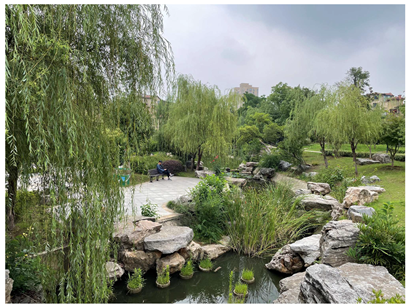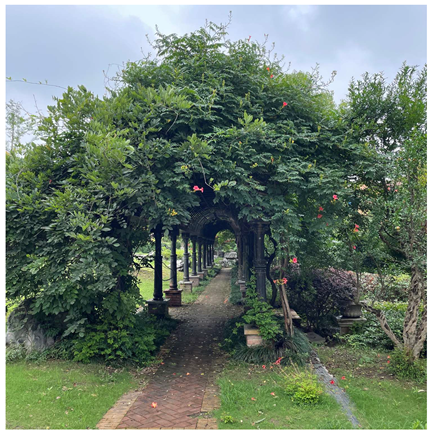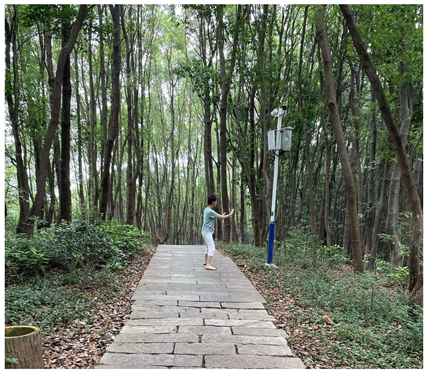Abstract
Restorative environments have a positive impact on improving the physical and mental health of the elderly. In China, the proportion of elderly residents in aging urban communities is significantly higher than in newly constructed ones, making it essential to understand the restorative potential of public open spaces (POSs) in these settings to promote the development of aging-in-place models. To investigate this issue, we employed the Fuzzy Delphi Method (FDM) and the Analytic Hierarchy Process (AHP) to construct an evaluation system for the restorative potential of public open spaces. Subsequently, we assessed the restorative effects of POSs in the Dabeizhuang community using 320 residents’ questionnaires and the fuzzy comprehension evaluation method. The results indicate that the dimension of safety is the most critical factor in creating restorative environments. In contrast, the dimension of comfort is the primary reason affecting the current evaluation of the community’s restorative environment. By establishing a restorative environment evaluation system, this research will facilitate the creation of more restorative environments in urban areas, thereby promoting active and healthy aging among elderly residents.
1. Introduction
The World Health Organization (WHO) introduced the concept of an Age-Friendly Community in 2005 to promote the full participation of older people in community life and healthy, active aging [1]. Therefore, promoting healthy aging has become a global concern. In 2010, the WHO launched the Global Network for Age-Friendly Cities and Communities (GNAFCC). Since then, the organization has expanded to 1445 cities and communities in 51 countries, covering more than 30 million people worldwide [2]. All countries are actively responding to the aging population issue, and China is no exception. As of the end of 2022, the number of Chinese seniors aged 60 and above stands at 28,040,000 people, accounting for 19.8 percent of China’s total population. By 2050, the number of seniors aged 60 and above is projected to exceed 400 million, marking the onset of a significant aging trend. The Chinese government has made it a national strategy to construct healthy and livable communities and proactively respond to aging [3,4].
Regardless of age or income level, older people tend to prefer to live in their own familiar homes or communities. This phenomenon, known as community-based aging in place, has become an essential way of coping with population aging in China. The desirability of the community influences the mode of aging in place. Generally, the higher the community’s desirability, the easier it is to build aging in place. The gravity of the demographic shift towards an aging population has led to a deterioration in the public environment [5], with buildings and municipal facilities becoming increasingly outdated [6]. This has made it easier to implement ageing-in-place initiatives in high-grade commercial communities than in older, less affluent areas. Furthermore, as the elderly cohort continues to grow, the activities of this demographic are becoming increasingly concentrated in the community space. In order to adapt to the deepening trend of aging, it is becoming increasingly important for the community public space to serve as an essential condition to ensure that the elderly can age at home [7,8]. In this context, the assessment of the restorative potential of public spaces in aged communities and the comprehension of the restoration of existing POSs in aged communities can, on the one hand, provide the optimal renovation strategies to enhance the restorative ability of aged communities; on the other hand, it can provide novel design concepts for the renovation of aged communities in the future [9].
The “restoration environments” theory is one of environmental psychology’s most critical research theories. Restoration environments refer to environmental settings that have restorative effects on human beings’ depleted physical and mental resources and abilities [10]. Stress Reduction Theory (SRT) and Attention Restorative Theory (ART) guide restorative environments. SRT focuses on helping people release stress and reduce negative emotions through restoration environments [11]. ART explains how natural environments restore spontaneous attention [12]. Restorative environment theory suggests that natural environments can effectively reduce people’s mental stress. Numerous studies have examined the relationship between restoration environments and positive physical and mental health in recent years. For example, exposure to natural environments can effectively reduce the production of negative emotions, such as anxiety, tension, anger, frustration, and fatigue [13], reduce the risk of senile dementia [14], and alleviate the symptoms of depression, schizophrenia, and other related mental disorders [15]. Based on these two major theories, a growing body of research has demonstrated that restorative environments reduce mental stress and produce beneficial restorative effects in older adults. These effects include (1) the alleviation of physical symptoms, (2) reductions in stress, and (3) improvements in overall well-being [16,17].
Nevertheless, there are still some research gaps in the current study. Firstly, although existing research has explored the impact of restoration environment elements on human health from a theoretical perspective, there is a lack of an effective assessment system for the actual construction and subsequent optimization of restoration environments. Secondly, research on restoration environments has focused on discussing a single environmental element but lacks a systematic summary and organization of restoration environments. Finally, as the elderly in old communities rely heavily on the public space in their communities and the restoration effect of community POSs can significantly affect their physical and mental health, it is necessary to understand the restoration effect of the existing POSs in old communities and to assess the restoration potential of POSs in old communities.
To address the gap above, this paper will examine whether the current POSs in older urban communities have sufficient restorative potential from the theory of restorative environments and whether the restorative effects of the space can meet the needs of older residents. This study aims to develop an assessment methodology to evaluate the restorative potential of POSs in high-density older urban communities. Furthermore, the study will discuss and elaborate on the potential for improvements to promote better restorative outcomes for older adults in POSs in older communities. In this study, Dabeizhuang, the most significant old community in Maanshan City, was selected to assess the restorative potential of POSs in old communities. The findings of this study can inform future policies and provide a reference for other cities in China.
To realize the above goals, this study first collects restoration environment quotas through related literature. After that, the FDM and AHP are used to establish a comprehensive evaluation framework for assessing the restorative potential of community POSs. Then, using the Dabeizhuang Community in Maanshan City, China, as a case study, we assess the current restorative potential of POSs in this community and understand the restorative effects of old urban communities’ POS environments on elderly residents. Finally, based on the empirical results, we provide strategies for the future optimization of old urban communities’ POSs. In addition, this study combines China’s national conditions and the relevant age classification of the United Nations Health Organization, defines old urban communities in this study as residential communities in urban areas built earlier than the year 2000, and elderly residents were defined in this study as people aged 60 or above.
2. Literature Review
2.1. Status of Research on Restorative Environment
Restoration environments are also known as resting environments [18], and previous studies have found benefits from different restoration environments. Some studies have demonstrated that gardens with green elements are superior to other spaces in terms of restorative effects [19]; forests produce restorative effects that helped the public during the COVID-19 pandemic to relieve stress and emotions [20]. Tombs in Scandinavia have better restorative effects that can help visitors relax, reflect, and contemplate [21]; blue spaces (marine and freshwater) can also be restoration environments [22]. It is, therefore, essential to explore the ability of different environmental features to provide restoration. Most previous research has focused on comparisons between natural and urban scenes [23]. However, green spaces [24], small parks [25], residential and public spaces [9], and streets [26] in urban spaces have been shown to play a restorative role in reducing stress and improving overall health.
Although the restorative effects of urban POSs have been proposed, the restorative potential of this specific type of urban residential POS has not yet been adequately investigated in the context of China’s widespread aging communities.
2.2. Methodology for the Study of the Environmental Assessment of Restoration
Despite the wide range of factors affecting restoration environment potential, in terms of the current methods of environment evaluation, three primary methods are used: quantitative testing, scale measurements, and evaluation systems. Quantitative testing is conducted through Electrocardiogram (ECG), Pulse Transit Time (PTT), Skin Conductance Response (SCR), muscle tone [11], Electroencephalogram (EEG) [27], blood pressure, and heart rate [28] to detect the subject’s immediate reaction and emotional changes in a specific environment. Hence, these physiological changes make the experimental quotas more objective and sensitive. Scale measurements through various self-report measures have been developed to assess the degree of perceived restoration in different environments. Standard scales include the Perceived Restorative Scale (PRS) [29], Restorative Components Scale (RCS) [30], Perceived Restorative Potential (PRP) [31], Self-Rating Restoration Scale (SRRS) [32], and Perceived Restorative Components Scale for Children (PRCS-C) [33]. Some scholars have highlighted that quantitative testing is susceptible to bias due to the rater’s physiological, emotional, and other personal factors [34]. This can lead to experimental errors and inaccurate experimental results. Although scale measurements are commonly employed in restoration assessment, the existing scales are not fully applicable to measuring restoration in POSs in older communities due to the distinctions between old urban community POSs and other urban POSs in terms of site size, service scope, and target users.
To prevent the introduction of experimental errors that may be caused by individual subjective awareness and to provide a comprehensive and multi-dimensional consideration of the specific assessment objectives and targets of this evaluation, this study has decided to construct a restorative effects assessment system based on existing research by using the expert survey method (FDM + AHP). The system will be expressly used to assess the restorative effects of POSs in old urban communities.
2.3. Status of Environmental Assessment for Restoration
Research has focused on the restorative effects of different environmental elements in urban environments, and these studies have shown the effects of different environmental elements on the restorative mental health of populations. Helena Nordh evaluated the environmental components of small urban parks and found that grass, shrubs, trees, pedestrian traffic, and the number of utilities were the keys to restorative effects [25]. Mårtensson evaluated the restorative potential of green outdoor environments for children and showed that large areas of trees, shrubs, and large, integrated outdoor areas increase the restorative potential of the environment [35]. In addition to exploring the effects of natural environmental elements on restorative effects, some studies have also assessed the restorative properties of the environment through various artificial environmental settings (e.g., public facilities, pavilions, sidewalks) and the fact that restorative potentials are also directly influenced by spatial layouts and activities. Communities are complex environments composed of multiple landscapes. Therefore, assessing community environments requires studying the combined effects of interactions between different environmental settings on restorative potential.
Few studies focus on the restorative characteristics of the old community at the micro-scale in current research. Constructing a community restorative assessment system will complement the existing research, improve the current restorative environment assessment system, and enrich the field of restorative environment assessment.
2.4. Initial Selection of Indicators and Dimensions for This Study
ART theory is an integral part of the theory of restorative environments, which suggests that an environment with restorative potential should offer four qualities: being away, richness, fascination, and compatibility. According to Kaplan, the meaning of each quality is shown in Table 1.

Table 1.
Explanation of the four dimensions of restoration environments.
Based on the ART theory [36], according to the healthcare gardens quality assessment tool [37], and combined with a comprehensive evaluation framework for the livability of communities [38], measurable evaluation indicators were collected from the natural landscape, spatial layout, community activities, and public facilities of the aging community.
Finally, combining the environmental characteristics of the old community, we selected 30 indicators based on the criteria hierarchy of mobility, richness, attraction, security, and comforts and based on the availability and quantifiability of data, as shown in Table 2.

Table 2.
Summary of quotas for assessing the resilience of POSs in old urban communities.
Movability is the primary condition for the environment to produce restorative effects [36]. The value of restorative effects depends partly on the type and number of spaces. The more places in a non-open space with detached life scenes, the better the restorative effect. The activities of older residents in the community can be divided into recreational, physical, social, and resting activities. Therefore, POSs in the community can contain green spaces, fitness spaces, leisure spaces, rest spaces, and road spaces.
Richness refers to the richness of recreational facilities [39], plant species [40], and forms of activities in POSs. Several studies have found that spaces with richness possess enough content and a specific structure to occupy the individual’s vision and mind, allowing the individual to fully engage in the exploration of the environment in which they are located so that people can have a better restorative experience [41].
Attraction refers to the ability of the information in the environment to attract the attention of the individual as one of the critical factors in whether the environment produces restorative effects [42], and an attractive environment elicits the autonomous attention of the individual who uses it for attentional distraction and restorative effects.
Comforts refer to sensory perceptions and personal comfort preferences. For example, uncomfortable chairs reduce the duration and frequency of people visiting a park [43]. Chairs facing the natural landscape are more conducive to mental stress relief [44].
Security is an essential prerequisite to guarantee that residents enjoy restorative effects in POSs [45,46]. A safe environment enables people to participate confidently and reduces unnecessary worries and concerns [47].
3. Methods
3.1. Study Area
The Dabeizhuang community is located in Maanshan City, Anhui Province. Maanshan is a city with a relatively high degree of population aging in China, with an aging percentage of 21.73%. In the 1980s, Maanshan City relied on the iron and steel industries, which brought together many labor-intensive state-owned enterprises and worker communities. With the development of urbanization in China, these employee communities have gradually transformed into “old urban communities”. The lack of elderly care facilities in the early stages of the construction of these communities has made it difficult for POSs to meet the current needs of the elderly. As a representative of a rapidly aging city with a large number of old urban communities, Maanshan City is not only one of the first pilot cities for comprehensive reform of the elderly care service industry in China but also one of the fourth batches of pilot cities for the reform of aging in place and community-based elderly care services with the support of the central government’s financial resources [48]. Therefore, it can be used as a model city for urban renewal and the promotion of healthy aging. We chose the Dabeizhuang community after visiting old urban communities in Maanshan City.
From the primary conditions of the community, the “Dabeizhuang” community belongs to Hudong Street, Huashan District, Maanshan City, and is currently the largest old urban community in Maanshan City. The community was built between 1980 and 1990, with a total area of 280,000 square meters, 134 houses, 4343 households, 15,354 people, and a population density of 54,800 people per square kilometer, which is a typical high-density old urban community, whose spatial form and development process are representative of China’s old urban communities.
According to the field research (Figure 1), the current status of community POSs shows that the number of POSs in the Dabeizhuang community is small, the area per capita is small, and there are few types of POSs. Among them, the Activity Square and Fitness Square are the two POSs with the most significant flow of people in the Dabeizhuang Community. Activity Square, with a construction area of about , is the largest POS in the community, is located in the southeast corner of the community, and contains multi-functional zones, such as recreation, leisure, and fitness spaces, which are suitable for all age groups to carry out activities in the POS. The Activity Square has an area of about . It is located in the northwest corner of the community park, which is mainly a fitness area and is suitable for middle-aged, young, and older adults who want to carry out activities.
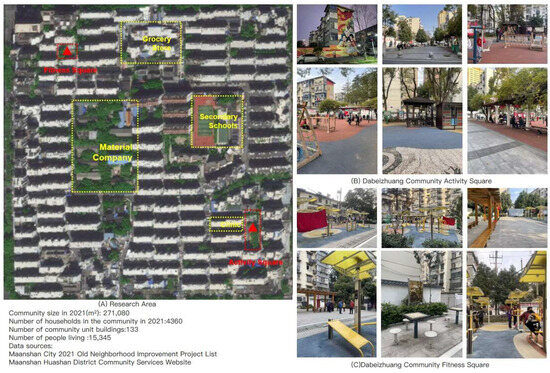
Figure 1.
Map of the current state of the community’s POSs in Dabeizhuang.
In terms of the location conditions of the community, the Dabeizhuang community is located in the center of the main urban area of Maanshan City, with a bank, company, police station, school, market, clinic, and other supporting units within its jurisdiction, making it an old urban community with a favorable location and good peripheral supporting facilities. For this type of old urban community POS, the restorative potential assessment is conducive to meeting the residents’ demand for elderly services and improving the quality of life of the elderly. On the other hand, it is of practical significance to promote the commercial growth of the neighborhood and improve the city’s image.
3.2. Research Design
This study combines three main research components with their corresponding research methodologies to form the design model used in this study. As shown in Figure 2 and Figure 3, the first level includes the research components: the first step is to determine the assessment indices of community POS restoration potential; the second step is to establish the assessment system of the restoration potential of old urban communities’ POSs; and the third step is to carry out the empirical assessment of the restoration potential of community POSs. The second level includes the corresponding research methods: the first method is the FDM expert questionnaire method, the second method utilizes the AHP method, and the third method is the FCE method.

Figure 2.
Schematic diagram of the conceptual hierarchy of the study.

Figure 3.
The flow chart of the study procedure.
3.2.1. Identification of Assessment Quotas
The FDM expert questionnaire method is a tool for assessing guidelines and screening quotas [49]. The assessment quotas for the restoration potential of community POSs cover various elements, including landscape, facilities, space functions, and property services. Therefore, we need to give professional judgment and advice through experts in related fields. In this regard, the traditional Delphi Method has to go through several questionnaires to achieve consistency, expending time and costs, though the calculation process only takes a single evaluation value as the expert’s opinion, which is prone to the distortion of the expert’s opinion. Therefore, we adopt the FDM to determine the quotas for the assessment of the restoration potential of the community.
In this study, after the index system for assessing the restoration potential of public space in old urban communities is screened by literature collation, a set of credible and reasonable assessment indices is established through the questionnaire survey of FDM experts, utilizing their expertise. Given this topic’s wide range of professional knowledge and fields, we interviewed seven experts and scholars from different perspectives and backgrounds in landscape, planning, and psychology. The seven experts on the panel were professors from several Chinese universities and landscape designers from design firms. The importance of each factor in the FDM questionnaire items was rated using a 0–10 scale, where the higher the score, the higher the importance, and each assessment item was given three levels of acceptable minimum, most appropriate, and acceptable maximum values based on the scoring criteria. A total of 7 questionnaires were distributed on 19 January 2024 and sent to the experts by email to fill in, and all of them were collected on 27 January 2024.
This study used the generalized mean model proposed by Klir and Folger to calculate the geometric mean as the expert consensus value . The expert consensus value refers to the intersection point where the maximum value of the minimum value meets the value of the maximum value , so that the higher the intersection point of the two lines, the higher the degree of expert consensus on the quota.
In addition, in selecting quotas, since the size of the threshold value will directly affect the number of quotas selected, the value of the threshold value is decided by the researcher according to their own research questions and assessment system [50]. Considering the overall assessment system, this study adopts a line graph approach, using green space as the turning point and deleting the quotas below the steeply falling turning point. The final decision is to take green space as the turning point and delete four quotas, including road safety, sky visibility, building facade aesthetics, and diversity of elderly care services, as shown in Figure 4.
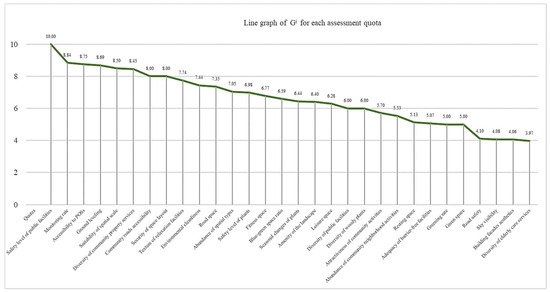
Figure 4.
Line graph of for each assessment quota.
The results of the FDM questionnaire retained 26 quotas, excluding 4 quotas (see Table 3). For the movability (A) dimension, five quotas were retained: green space, fitness space, leisure space, road space, and resting space. For the diversity (B) dimension, five quotas were retained: diversity of woody plants, diversity of public facilities, abundance of spatial types, diversity of community property services, and abundance of community neighborhood activities. Six quotas were retained for the attraction (C) dimension: amenity of the landscape, adequacy of barrier-free facilities, blue–green space ratio, environmental cleanliness, attractiveness of community activities, and community road accessibility. The five quotas retained for the comforts (D) dimension were greening rate, seasonal changes in plants, texture of relaxation facilities, suitability of spatial scale, and accessibility to POS. The security (E) dimension retains the security level of plants, the security level of public facilities, the security of space layout, the monitoring rate, and ground leveling.

Table 3.
FDM questionnaire results.
3.2.2. Establishment of an Assessment System
AHP is a multi-objective decision-making methodology proposed by T.L. Saaty in the 1980s to combine qualitative and quantitative analysis systems [51]. AHP compares and ranks the issues based on pre-determined criteria and later compares and ranks the relative importance of issues based on a questionnaire that collects the respondents’ preferences [52]. The pairwise comparison of issues generates hierarchies and finds the optimal solution. Due to the many quotas that assess the restorative potential of the old urban community’s POSs, the AHP was used to calculate the weights of the quotas.
In this study, after identifying the critical quotas for the community’s POS restorative potential assessment through FDM, 5 criterion layer quotas of movability, richness, attraction, comforts, and security were selected in the assessment system, with 26 quota-layer quotas (Table 3). A panel of experts calculated the weights of each quota. The questionnaire was designed using Saaty’s 1–9 scale and sent to experts for completion. After collecting all questionnaires, the quota weight values were calculated, and a consistency test was performed to construct A–E, A1–A5, B1–B5, C1–C6, D1–D5, and E1–E5 judgment matrices for each expert based on the questionnaires (Appendix A Table A1, Table A2, Table A3, Table A4, Table A5 and Table A6).
According to the weight calculation steps of AHP, the weights of the criterion hierarchy (A, B, C, D, E) are calculated first, and then the weights of each quota hierarchy in each criterion hierarchy are calculated to obtain the weights of 26 specific quotas, as shown in Table 4.

Table 4.
Weighting values of assessment quotas.
The ranked values of the restorative potential assessment quotas for the old urban communities’ POSs were obtained after calculating the combined weights according to the AHP, and a scatterplot was created, as shown in Figure 5.
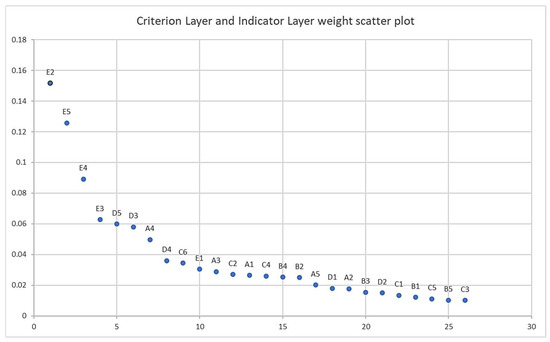
Figure 5.
Scatterplot of assessment quotas.
3.2.3. Questionnaire Survey
FCE is based on fuzzy mathematics and uses the principle of fuzzy relationship synthesis to quantify factors that are difficult to quantify. It also comprehensively evaluates the subordinate rank status of that being evaluated. Therefore, it has a significant advantage in dealing with uncertainty and imperfect information. Due to the intense subjectivity and vagueness of residents’ scoring and judging, FCE is used.
To accurately measure the restorative potential of the community’s POSs, we designed a fuzzy composite evaluation questionnaire for the residents through the assessment system above. A five-point Likert scale method was used to administer the questionnaire to residents. The five options for each question correspond to scores from 1 to 5, and the corresponding scoring criteria were developed to set the restorative evaluation level, with grade I a score of [100, 90), grade II a score of [90, 80), grade III a score of [80, 70), grade IV a score of [70, 60), and grade V a score of [60, 55) (Table 5).

Table 5.
Evaluation criteria.
In March 2024, 320 paper questionnaires were distributed, and 314 questionnaires were recovered in the Dabeizhuang community, with a recovery rate of 98.13%. Since the target of this questionnaire is the elderly, considering the actual situation of the elderly, we use easy-to-understand ways to express the questions in the questionnaire survey. For example, for “Security of space layout”, we asked, “Do you think you are vulnerable to bumping when doing activities in the community’s POS?”. After collecting all the questionnaires, we applied the FCE principle of maximum membership degree, resulting in a Level III restorative evaluation level for the Dabeizhuang community. After the de-fuzzy calculation of the criterion hierarchy and target hierarchy evaluation, the result of the restorative evaluation of the Dabeizhuang community can be obtained as 72.23.
4. Empirical Results
The results of the resident ratings and grades for the restorative potential of the POS in the Dabeizhuang community are shown in Table 6 The POS restorative potential rating for the community’s POS in the Dabeizhuang Community is grade III, which is an average level. According to the comprehensive weights of the assessment system of public space restorative potential in old urban communities (Table 4), experts attach great importance to the security (E) and comforts (D) of public spaces in elderly communities. The results of the FCE assessment showed that among the POS environmental dimensions in the older urban communities, older residents perceived safety (E) as the best and comfort (D) as the worst (Figure 6), which is opposed to the youth’s impression of the Dabeizhuang communities. The indicators of seasonal variation of plants, appropriateness of spatial scale, attractiveness of community activities, green space, and resting space need to be improved (Figure 7).

Table 6.
FCE resident score results.
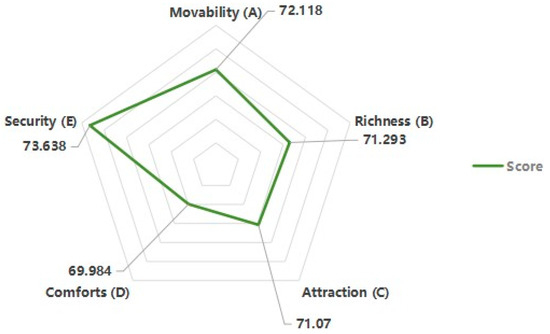
Figure 6.
Scores on five environmental dimensions of POS restoration environments in the Dabeizhuang community.
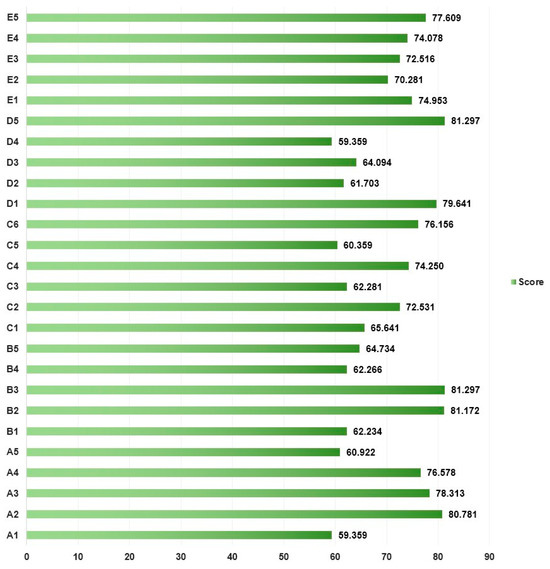
Figure 7.
Composite evaluation score for each indicator of the Dabeizhuang Community POSs.
4.1. Movability Dimension—The Green and Amenity Space Amount Is Low and Underutilized
The FCE results of the residents showed that “movability” (A) was evaluated as “III”, with an evaluation result of “72.118”, which is an average level (Figure 8). Among them, the evaluation results of “Green space” (A1) and “Resting space” (A5) indicators are lower than the average. This is mainly because the planning concept of ‘district-group-courtyard’ in the Dabeizhuang community puts too much emphasis on the hierarchy of spatial structure, making it difficult to break through the original spatial structure in the layout of the existing POS. It is difficult to increase the number of green and resting spaces. On the other hand, the space utilization rate of Dabeizhuang POS is very low; nearly one-third of the space is difficult for the residents to use due to the spatial layout, such as setting the rest space on both sides of the driveway and at the turning point of the road (Figure 9). This assessment highlights the current challenges in the Dabeizhuang community, particularly in the areas of green and resting spaces, that need to be addressed.
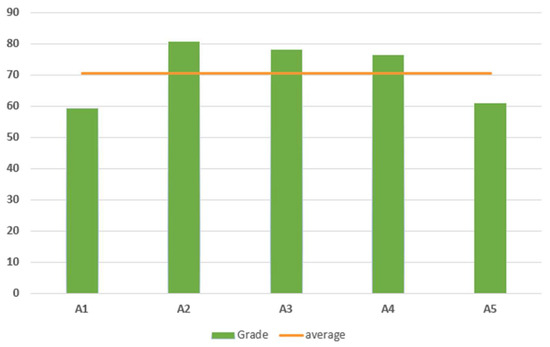
Figure 8.
Resident assessment results for the movability dimension.
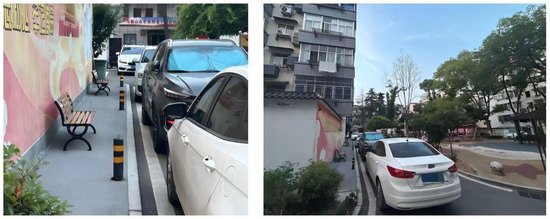
Figure 9.
Photos from the field at Dabeizhuang Community POSs.
4.2. Richness Dimension—The Underlying Community Property Services Limit Plant Richness
At the criterion level, “richness” (B) has the lowest impact on the restorative potential of POSs, with a weight of 0.0883, and experts do not attach great importance to this quota. The results of the FCE of the residents showed that the richness of the Dabeizhuang Community was assessed as “level III”, with a score of 71.293, which is an average level, in which the residents were generally interested in the “diversity of woody plants” (B1) and the “diversity of community property services” (B4) (Figure 10). In-depth research found that the ”diversity of community property services” (B4) positively correlates with the “diversity of woody plants” (B1). The reason for this is that the property services in the existing old communities usually only provide essential safety maintenance and cleaning services, and the lack of funding and management system makes it difficult to provide more abundant greening and landscape maintenance services.
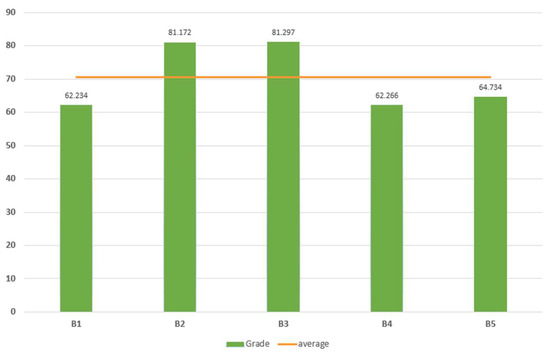
Figure 10.
Resident assessment results for the richness dimension.
4.3. Attraction Dimension—Existing Community Activities Are Not Attractive to Older Residents
According to the residents’ FCE results, the Dabeizhuang community’s POS is evaluated as “III” with an evaluation result of “71.070”, which is at an average level. The “Attractiveness of Community Activities” (C5) score is only “60.359”, which is the indicator with the lowest score under the dimension of “Attractiveness” (C) (Figure 11). The main reason for this is that, on the one hand, the activities held by the Dabeizhuang community are in a single form, lacking in innovativeness and interest, and are less attractive to the elderly residents; on the other hand, the lack of effective organization and management of community activities has resulted in the chaotic organization of the activities, which affects the residents’ motivation to participate in the activities.
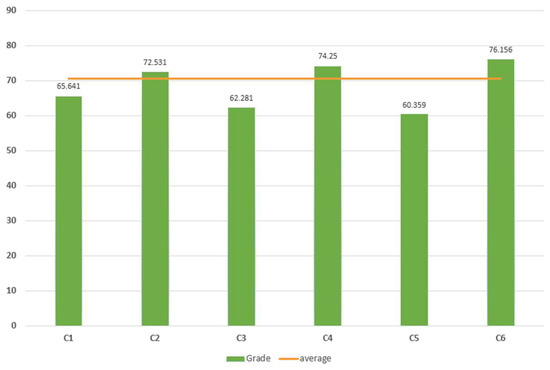
Figure 11.
Resident assessment results for the attractiveness dimension.
4.4. Comforts Dimension—The Key to Improving Comfort Is to Increase Attention to Spatial Suitability
Combined with Figure 12, residents rated “accessibility to POS” (D5) and “greening rate” (D1) highly but rated “seasonal changes of plants” (D2), “the texture of relaxation facilities” (D3), and “suitability of spatial scale” (D4) very low. The lowest rating was for “suitability of spatial scale” (D4) (Figure 12). Overall, there is a big difference between the comfort of POSs in the Dabeizhuang community and the needs of residents. Combined with the weights of the indicators, the seasonal changes in the landscape, the comfort of public facilities, and the comfort of spatial scale significantly affect the POSs’ restorative potential. However, these factors have been seriously neglected in the planning and designing of POSs in older communities.
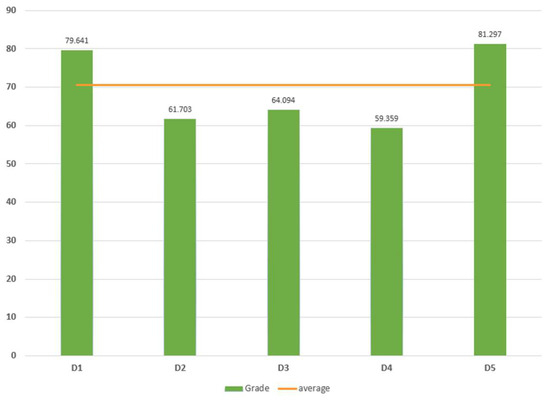
Figure 12.
Resident assessment results for the comforts dimension.
4.5. Security Dimensions—The Dimensions That Have the Greatest Impact on POS Restorative Potential
Compared with the other quotas in the criterion hierarchy, the experts considered that “security” (E) has the most significant influence on the restorative potential of POSs, with a weight of 0.4597. According to the results of the FCE by residents, the evaluation level of “security” (E) in the community’s POSs in Dabeizhuang is “level III”, and the evaluation result is “73.638”, at an average level (Figure 13).
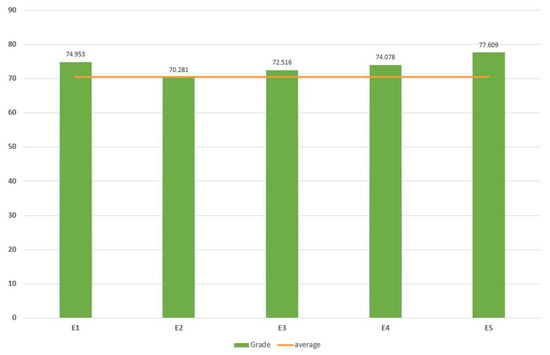
Figure 13.
Resident assessment results for the security dimension.
The index hierarchy is analyzed in terms of “security” (E), including “safety level of plants” (E1); “safety level of public facilities” (E2); “safety of space layout” (E3); “monitoring rate” (E4); and “ground leveling” (E5). The scores are similar, with no significant differences. All are at the “average” level.
5. Discussion
With the irreversible aging trend and high-density urban complexes, healthy residential POSs have become essential to constructing livable, aging environments that cannot be ignored. The research in this study explores the current restorative potential of urban communities’ POSs for older residents. We provide a comprehensive assessment of the community’s POSs in terms of five dimensions: “movability” (A), “richness” (B), “attraction” (C), “comforts” (D), and “security” (E).
Combined with Figure 7, the following main issues need to be addressed: (1) in terms of natural landscape, residents are dissatisfied with the seasonal changes of plants in the POSs in the Dabeizhuang community (D2); (2) in terms of spatial layout, residents have the lowest evaluation of the suitability of spatial scale (D4), followed by residents who are dissatisfied with the size of green space (A1) and the resting space (A5) in the community; (3) in terms of community activities, residents felt that the current community activities lacked attractiveness (C5), and participants were unable to feel social enjoyment in the activities.
5.1. Natural Landscape
Low-quality green spaces are a common problem in old urban communities. Natural landscapes, as the most essential part of the restoration environment, are crucial for improving the restoration of community POSs. Natural landscapes can be improved in terms of plant diversity, visual effects, and seasonal changes.
The seasonal changes of plants are easy to ignore. In a previous study [53], some scholars observed that the elderly usually choose spring, summer, and fall seasons, when the temperature is comfortable. This is the best time to go out for outdoor activities, and they prefer the calm and ventilated space in summer and the warm and sunny space in winter. In this research, we also came to the same conclusion; for example, the flow of people in Dabeizhuang’s Activity Square is much higher than in Fitness Square. The reason for this phenomenon is that Fitness Square is in the building enclosure, coupled with the large canopy of surrounding trees; further, the amount of dense vegetation in the entire space is almost in the shadows of the trees, and the entire space lacks sunlight, with low temperatures. In winter, the elderly like heat and hate cold, so some of the elderly residents of Fitness Square will go to Activity Square for outdoor activities. It can be seen that in the community’s POS landscape configuration, the designer should not only pay attention to the visual effect of the landscape presentation but also understand the local climate and seasonal changes for the actual situation of different spaces on the number of green plants for a reasonable configuration.
5.2. Community Activities
The attractiveness of community activities has often been overlooked in previous studies. However, this factor is essential for older people, who are more likely than younger people to suffer from mental health problems, such as depression and autism. Older people’s social connections tend to weaken with age, and attractive community activities not only increase the frequency of their participation in community activities but also strengthen their social relationships, effectively preventing the onset of mental health problems.
5.3. The Spatial Layout
The appropriateness of spatial scale is a prerequisite for the restorative potential enhancement of POSs in old communities. Appropriate spatial scale can not only satisfy the diverse activities of residents but also provide richer experiences for residents’ activities. Too large a space can leave older people feeling empty and lacking a sense of belonging, while too small can limit their range of activities and social interactions. Failure to consider the appropriateness of the spatial scale of the POSs will result in a mismatch between the spatial experiences and needs of older people and a weakening of their needs. Another important aspect of spatial scale is that POSs are essential for the elderly to socialize and carry out daily activities. Therefore, the construction of appropriately scaled POSs can promote communication and interaction among the elderly, which can help alleviate their loneliness and depression and improve their quality of life and sense of well-being.
5.4. Significance and Comparison with Other Studies
This study examines the relevant international studies on the assessment of restorative environments. Adeleh Nejati assessed the restoration potential of a hospital lounge using visual simulation [54], and Luo S assessed the restoration potential of an urban gazebo using VR [18]. Compared to the aforementioned studies, the methods and results used in this study have the following differences and contributions.
Regarding the methods used, Adeleh Nejati and Luo S used visual simulation and VR technology to assess the restoration effect of visual stimulation. This study established the evaluation system using an expert questionnaire, and a resident questionnaire was used for the field evaluation. This combination of experts and residents can improve the evaluation results’ accuracy and the design strategy’s fairness.
Secondly, in terms of the design of the rating system, Adeleh Nejati and Luo S’s assessment indicators are mainly from the PSD scale, but the PSD scale does not apply to all environments; for example, animals are the type of indicators that we can hardly find in urban communities. As Tenngart Ivarsson points out [55], existing frameworks are complex because they list functions rather than guiding design. To bridge the gap between research and design and to achieve optimization of the subsequent restorative potential of the community POSs, we have drawn on the comprehensive evaluation framework for the livability of communities, integrating different types of indicators that interact with people within the community POSs and establishing restorative potential assessments that can be applied to the POSs of an aging community after specific scientific justification.
Finally, in contrast to the results found by Adeleh Nejati and Luo S, our study used “security” as a stand-alone environmental dimension to assess whether the entire public space POSs provide sufficient security to the people who use it. The results of the AHP showed that security > comforts > movability > attraction > richness, which proves that security is the most critical environmental quality for the design of POS rehabilitation in old urban communities. Based on the above findings, the inclusion of this dimension in this study represents a refinement of the assessment system for the restorative potential of POSs in old urban communities.
6. Conclusions
This study refers to related studies, follows the scientific evaluation principles, combines the actual situation of the old community from the five dimensions of activity, diversity, attractiveness, comfort, and safety, and finally, selects 26 evaluation indicators to construct a restorative potential evaluation system for the construction of POSs of the old community, and the construction of the indicator system is a combination of FDM-AHP determination, where FDM is used for the screening of indicators. AHP is used to determine indicator weights. Then, we used questionnaires to collect community residents’ evaluations and FCE to calculate the comprehensive score of POS restorative potential in the Dabeizhuang community. The results of the POS restorative potential assessment of the Dabeizhuang community were analyzed in terms of the natural landscape, spatial layout, public facilities, and community activities. We found that the current old community still lacks the suitability of spatial scale, the attractiveness of community activities, seasonal change of plants, green space, and rest space.
The study results show that security is the most critical dimension in assessing POS restoration potential in older urban neighborhoods, followed by comfort, movability, and attraction, while richness is the lowest. Secondly, from the FCE composite score, “seasonal changes of plants” (D2), “green space” (A1), “resting space” (A5), “suitability of spatial scale” (D4), and “attractiveness of community activities” (C5) are the most essential concerns for community residents.
Three countermeasures are proposed for the transformation of old urban communities in response to the above problems:
- (1)
- Landscaping improves the quality of the natural landscape of the POSs in older communities, pays attention to the balance between stability and seasonality in community landscape design, and optimizes the visual impact of green landscapes.
- (2)
- In terms of spatial layout, on the one hand, the number of green spaces and resting spaces is increased by using fragmented and unused spaces in the community, and on the other hand, the standards of human comfort in various types of spaces are clarified to increase their comfort.
- (3)
- The community property management system has been optimized for district management. In contrast, the creation of community activities has been strengthened to encourage the elderly to participate in community activities and promote neighborhood interaction.
Finally, there are some limitations to this study. Firstly, due to the limited human and time resources, our study only covers one season. Although we found that the season affects the restorative potential of POSs, the specific value of this influence effect needs to be further developed. Secondly, to reduce the interference of other variables, the subjects of this experiment belong to an old urban community in a small- or medium-sized city, which has its spatial characteristics and representativeness, so whether or not the restorative factors affecting the POSs change after a change of localities and communities still needs to be verified by subsequent experiments. In conclusion, as the aging process continues to develop and the government attaches importance to a livable environment for the elderly, the construction of restoration environments for community POSs has excellent potential for development. The results of these studies can provide a reference for the planning and design of future senior livable cities in China, help meet the increasing mental health needs of residents, and promote the development of the model of aging in place in urban communities.
Author Contributions
Conceptualization, J.H. and D.H.; methodology, J.H. and D.H.; software, Y.S. (Yimin Song); validation, Y.S. (Ying Sheng); formal analysis, Y.S. (Yimin Song) and Y.S. (Ying Sheng); investigation, Y.S. (Ying Sheng) and Y.Z.; resources, Y.S. (Yimin Song); data curation, D.H.; writing—original draft preparation, J.H. and D.H.; writing—review and editing, J.H. and Y.S. (Yimin Song); visualization, Y.Z.; supervision, D.H.; project administration, D.H.; funding acquisition, D.H. All authors have read and agreed to the published version of the manuscript.
Funding
Anhui University of Technology’s Young Teachers’ Research Fund project in 2022, “Research on the Planning and Design of Public Spaces in Smart Communities in Anhui Province” (QS202204). Anhui Province’s Key Research Program for Higher Education Institutions in 2023, “Optimization Strategies for Experiencing Huizhou Traditional Villages’ Rural Culture from the Perspective of Service Design” (2023AH051073). Anhui Province Social Sciences Innovation and Development Research Project in 2023, “Research on Optimization Strategies for Experiencing Huizhou Earthen Building Villages’ Rural Culture from the Perspective of Service Design” (2023CX113).
Data Availability Statement
Data are contained within the article.
Conflicts of Interest
The authors declare no conflicts of interest.
Appendix A

Table A1.
A–E judgment matrix for expert 1.
Table A1.
A–E judgment matrix for expert 1.
| A | B | C | D | E | Weight | |
|---|---|---|---|---|---|---|
| A | 1 | 2 | 2 | 2 | 2 | 0.3270 |
| B | 1/2 | 1 | 1 | 1 | 2 | 0.1846 |
| C | 1/2 | 1 | 1 | 2 | 2 | 0.2166 |
| D | 1/2 | 1 | 1/2 | 1 | 2 | 0.1635 |
| E | 1/2 | 1/2 | 1/2 | 1/2 | 1 | 0.1083 |
Here, , and, according to the formula, . , the judgment matrix has acceptable consistency.

Table A2.
A1–A5 judgment matrix for expert 1.
Table A2.
A1–A5 judgment matrix for expert 1.
| A1 | A2 | A3 | A4 | A5 | Weight | |
|---|---|---|---|---|---|---|
| A1 | 1 | 1/2 | 1 | 2 | 1 | 0.1846 |
| A2 | 2 | 1 | 2 | 2 | 2 | 0.3270 |
| A3 | 1 | 1/2 | 1 | 2 | 2 | 0.2166 |
| A4 | 1/2 | 1/2 | 1/2 | 1 | 1/2 | 0.1083 |
| A5 | 1 | 1/2 | 1/2 | 2 | 1 | 0.1635 |
Here, , and, according to the formula, . , the judgment matrix has acceptable consistency.

Table A3.
B1–B5 judgment matrix for expert 1.
Table A3.
B1–B5 judgment matrix for expert 1.
| B1 | B2 | B3 | B4 | B5 | Weight | |
|---|---|---|---|---|---|---|
| B1 | 1 | 2 | 2 | 1 | 1 | 0.2570 |
| B2 | 1/2 | 1 | 2 | 2 | 1 | 0.2248 |
| B3 | 1/2 | 1/2 | 1 | 2 | 1 | 0.1724 |
| B4 | 1 | 1/2 | 1/2 | 1 | 2 | 0.1782 |
| B5 | 1 | 1 | 1 | 1/2 | 1 | 0.1675 |
, and, according to the formula, . , the judgment matrix has acceptable consistency.

Table A4.
C1–C6 judgment matrix for expert 1.
Table A4.
C1–C6 judgment matrix for expert 1.
| C1 | C2 | C3 | C4 | C5 | C6 | Weight | |
|---|---|---|---|---|---|---|---|
| C1 | 1 | 1 | 2 | 1 | 2 | 1 | 0.2062 |
| C2 | 1 | 1 | 1 | 3 | 1 | 1 | 0.1865 |
| C3 | 1/2 | 1 | 1 | 2 | 1 | 2 | 0.1798 |
| C4 | 1 | 1/3 | 1/2 | 1 | 1/3 | 1 | 0.1049 |
| C5 | 1/2 | 1 | 1 | 3 | 1 | 1/2 | 0.1579 |
| C6 | 1 | 1 | 1/2 | 1 | 2 | 1 | 0.1646 |
, and, according to the formula, . , the judgment matrix has acceptable consistency.

Table A5.
D1–D5 judgment matrix for expert 1.
Table A5.
D1–D5 judgment matrix for expert 1.
| D1 | D2 | D3 | D4 | D5 | Weight | |
|---|---|---|---|---|---|---|
| D1 | 1 | 1/2 | 1 | 1 | 2 | 0.1969 |
| D2 | 2 | 1 | 1 | 2 | 1 | 0.2643 |
| D3 | 1 | 1 | 1 | 1/2 | 1 | 0.1709 |
| D4 | 1 | 1/2 | 2 | 1 | 1 | 0.1969 |
| D5 | 1/2 | 1 | 1 | 1 | 1 | 0.1709 |
, and, according to the formula, . , the judgment matrix has acceptable consistency.

Table A6.
E1–E5 judgment matrix for expert 1.
Table A6.
E1–E5 judgment matrix for expert 1.
| E1 | E2 | E3 | E4 | E5 | Weight | |
|---|---|---|---|---|---|---|
| E1 | 1 | 1 | 2 | 1/3 | 1/3 | 0.1353 |
| E2 | 1 | 1 | 1/2 | 1/2 | 1/2 | 0.1178 |
| E3 | 1/2 | 2 | 1 | 1/3 | 1/2 | 0.1307 |
| E4 | 3 | 2 | 3 | 1 | 1/2 | 0.2783 |
| E5 | 3 | 2 | 2 | 2 | 1 | 0.3378 |
, and, according to the formula, . , the judgment matrix has acceptable consistency.
References
- Plouffe, L.; Kalache, A. Towards Global Age-Friendly Cities: Determining Urban Features that Promote Active Aging. J. Urban Health 2010, 87, 733–739. [Google Scholar] [CrossRef] [PubMed]
- About the Global Network for Age-friendly Cities and Communities. Available online: https://extranet.who.int/agefriendlyworld/who-network/ (accessed on 1 January 2023).
- Outline of the 14th Five-Year Plan (2021–2025) for National Economic and Social Development and Vision 2035 of the People’s Republic of China. Available online: https://www.fujian.gov.cn/english/news/202108/t20210809_5665713.htm (accessed on 21 December 2023).
- Ke, Y. Annual Report on Construction and Development of China Urban Community (2022); Social Science Literature Press: Beijing, China, 2023. [Google Scholar]
- Jiang, C.H.; Xiao, Y.Q.; Cao, H.Y. Co-Creating for Locality and Sustainability: Design-Driven Community Regeneration Strategy in Shanghai’s Old Residential Context. Sustainability 2020, 12, 2997. [Google Scholar] [CrossRef]
- Xiao, J.Y.; Liu, H.Y.; Wu, J. The Status Quos and Causes of Concentrated Elderly Populations in Old Urban Communities in China. Sustainability 2022, 14, 12612. [Google Scholar] [CrossRef]
- Cai, Y.; Yang, X.; Li, D. “Micro-transformation”: The RenewalMethod of Old Urban Communtity. Urban Dev. Stud. 2017, 24, 29–34. [Google Scholar]
- Chen, M.Y.; Bolt, G.; Yu, L.; Hooimeijer, P. The impact of the residential environment on Chinese older people’s aging-in-place intentions: A mediation and moderation analysis. Habitat Int. 2023, 140, 102908. [Google Scholar] [CrossRef]
- Shu, S.; Meng, L.K.; Piao, X.; Geng, X.C.; Tang, J.X. Effects of Audio-Visual Interaction on Physio-Psychological Recovery of Older Adults in Residential Public Space. Forests 2024, 15, 266. [Google Scholar] [CrossRef]
- Zhao, H.; Wu, J. Review on Restorative Environment: The Theories and Evaluation. China J. Health Psychol. 2010, 18, 117–121. [Google Scholar] [CrossRef]
- Ulrich, R.S.; Simons, R.F.; Losito, B.D.; Fiorito, E.; Miles, M.A.; Zelson, M. Stress recovery during exposure to natural and urban. J. Environ. Psychol. 1991, 11, 201–230. [Google Scholar] [CrossRef]
- Kaplan, R.; Kaplan, S. The Experience of Nature: A Psychological Perspective; Cambridge University Press: Cambridge, UK, 1989. [Google Scholar]
- Gascon, M.; Triguero-Mas, M.; Martínez, D.; Dadvand, P.; Forns, J.; Plasència, A.; Nieuwenhuijsen, M.J. Mental health benefits of long-term exposure to residential green and blue spaces: A systematic review. Int. J. Environ. Res. Public Health 2015, 12, 4354–4379. [Google Scholar] [CrossRef]
- Slawsky, E.D.; Hajat, A.; Rhew, I.C.; Russette, H.; Semmens, E.O.; Kaufman, J.D.; Leary, C.S.; Fitzpatrick, A.L. Neighborhood greenspace exposure as a protective factor in dementia risk among U.S. adults 75 years or older: A cohort study. Environ. Health 2022, 21, 14. [Google Scholar] [CrossRef]
- Zhifeng, W.; Yin, R. The influence of greenspace characteristics and building configuration on depression in the elderly. Build. Environ. 2021, 188, 107477. [Google Scholar] [CrossRef]
- Scopelliti, M.; Giuliani, M.V. Restorative environments in later life: An approach to well-being from the perspective of environmental psychology. J. Hous. Elder. 2006, 19, 203–226. [Google Scholar] [CrossRef]
- Boffi, M.; Pola, L.G.; Fermani, E.; Senes, G.; Inghilleri, P.; Piga, B.E.A.; Stancato, G.; Fumagalli, N. Visual post-occupancy evaluation of a restorative garden using virtual reality photography: Restoration, emotions, and behavior in older and younger people. Front. Psychol. 2022, 13, 927688. [Google Scholar] [CrossRef] [PubMed]
- Luo, S.; Shi, J.; Lu, T.; Furuya, K. Sit down and rest: Use of virtual reality to evaluate preferences and mental restoration in urban park pavilions. Landsc. Urban Plan. 2022, 220, 104336. [Google Scholar] [CrossRef]
- Cervinka, R.; Schwab, M.; Schönbauer, R.; Hämmerle, I.; Pirgie, L.; Sudkamp, J. My garden—My mate? Perceived restorativeness of private gardens and its predictors. Urban For. Urban Green. 2016, 16, 182–187. [Google Scholar] [CrossRef]
- Pichlerová, M.; Vybost’ok, J.; Önkal, D.; Lamatungga, K.E.; Tamatam, D.; Marcineková, L.; Pichler, V. Increased appreciation of forests and their restorative effects during the COVID-19 pandemic. Ambio 2023, 52, 647–664. [Google Scholar] [CrossRef]
- Nordh, H.; Evensen, K.H.; Skår, M. A peaceful place in the city—A qualitative study of restorative components of the cemetery. Landsc. Urban Plan. 2017, 167, 108–117. [Google Scholar] [CrossRef]
- Nicolosi, V.; Wilson, J.; Yoshino, A.; Viren, P. The restorative potential of coastal walks and implications of sound. J. Leis. Res. 2021, 52, 41–61. [Google Scholar] [CrossRef]
- Neale, C.; Lopez, S.; Roe, J. Psychological Restoration and the Effect of People in Nature and Urban Scenes: A Laboratory Experiment. Sustainability 2021, 13, 6464. [Google Scholar] [CrossRef]
- Grahn, P.; Stigsdotter, U.K. The relation between perceived sensory dimensions of urban green space and stress restoration. Landsc. Urban Plan. 2010, 94, 264–275. [Google Scholar] [CrossRef]
- Nordh, H.; Alalouch, C.; Hartig, T. Assessing restorative components of small urban parks using conjoint methodology. Urban For. Urban Green. 2011, 10, 95–103. [Google Scholar] [CrossRef]
- Zhao, J.W.; Wu, J.X.; Wang, H.D. Characteristics of urban streets in relation to perceived restorativeness. J. Expo. Sci. Environ. Epidemiol. 2020, 30, 309–319. [Google Scholar] [CrossRef] [PubMed]
- Chen, Z.; He, Y.; Yu, Y. Attention restoration during environmental exposure via alpha-theta oscillations and synchronization. J. Environ. Psychol. 2020, 68, 101406. [Google Scholar] [CrossRef]
- Lotfi, Y.A.; Refaat, M.; El Attar, M.; Abdel Salam, A. Vertical gardens as a restorative tool in urban spaces of New Cairo. Ain Shams Eng. J. 2020, 11, 839–848. [Google Scholar] [CrossRef]
- Hartig, T.; Korpela, K.; Evans, G.W.; Garling, T. A measure of restorative quality in environments. Scand. Hous. Plan. Res. 1997, 14, 175–194. [Google Scholar] [CrossRef]
- Laumann, K.; Gärling, T.; Stormark, K.M. Rating scale measures of restorative components of environments. J. Environ. Psychol. 2001, 21, 31–44. [Google Scholar] [CrossRef]
- Herzog, T.R.; Colleen; Maguire, P.; Nebel, M.B. Assessing the restorative components of environments. J. Environ. Psychol. 2003, 23, 159–170. [Google Scholar] [CrossRef]
- Han, K.T. A reliable and valid self-rating measure of the restorative quality of natural environments. Landsc. Urban Plan. 2003, 64, 209–232. [Google Scholar] [CrossRef]
- Bagot, K.L. Perceived restorative components: A scale for children. Child. Youth Environ. 2004, 14, 107–129. [Google Scholar] [CrossRef]
- Fei, X.; Zhang, Y.; Kong, D.; Huang, Q.; Wang, M.; Dong, J. Quantitative Model Study of the Psychological Recovery Benefit of Landscape Environment Based on Eye Movement Tracking Technology. Sustainability 2023, 15, 11250. [Google Scholar] [CrossRef]
- Mårtensson, F.; Boldemann, C.; Söderström, M.; Blennow, M.; Englund, J.E.; Grahn, P. Outdoor environmental assessment of attention promoting settings for preschool children. Health Place 2009, 15, 1149–1157. [Google Scholar] [CrossRef]
- Kaplan, S. The restorative benefits of nature-toward an integrative framework. J. Environ. Psychol. 1995, 15, 169–182. [Google Scholar] [CrossRef]
- Bengtsson, A.; Grahn, P. Outdoor environments in healthcare settings: A quality evaluation tool for use in designing healthcare gardens. Urban For. Urban Green. 2014, 13, 878–891. [Google Scholar] [CrossRef]
- Liang, X.J.; Liu, Y.L.; Qiu, T.Q. Livability Assessment of Urban Communities considering the Preferences of Different Age Groups. Complexity 2020, 2020, 1–15. [Google Scholar] [CrossRef]
- Kaczynski, A.T.; Potwarka, L.R.; Saelens, B.E. Association of park size, distance, and features with physical activity in neighborhood parks. Am. J. Public Health 2008, 98, 1451–1456. [Google Scholar] [CrossRef] [PubMed]
- van den Berg, A.E.; Maas, J.; Verheij, R.A.; Groenewegen, P.P. Green space as a buffer between stressful life events and health. Soc. Sci. Med. 2010, 70, 1203–1210. [Google Scholar] [CrossRef] [PubMed]
- Paquet, C.; Orschulok, T.P.; Coffee, N.T.; Howard, N.J.; Hugo, G.; Taylor, A.W.; Adams, R.J.; Daniel, M. Are accessibility and characteristics of public open spaces associated with a better cardiometabolic health? Landsc. Urban Plan. 2013, 118, 70–78. [Google Scholar] [CrossRef]
- Sato, I.; Conner, T.S. The quality of time in nature: How fascination explains and enhances the relationship between nature experiences and daily affect. Ecopsychology 2013, 5, 197–204. [Google Scholar] [CrossRef]
- Pasha, S.; Shepley, M.M. Research note: Physical activity in pediatric healing gardens. Landsc. Urban Plan. 2013, 118, 53–58. [Google Scholar] [CrossRef]
- Nordh, H.; Østby, K. Pocket parks for people—A study of park design and use. Urban For. Urban Green. 2013, 12, 12–17. [Google Scholar] [CrossRef]
- Barnett, D.W.; Barnett, A.; Nathan, A.; Van Cauwenberg, J.; Cerin, E.; Council on Environment and Physical Activity (CEPA)–Older Adults Working Group. Built environmental correlates of older adults’ total physical activity and walking: A systematic review and meta-analysis. Int. J. Behav. Nutr. Phys. Act. 2017, 14, 103. [Google Scholar] [CrossRef] [PubMed]
- Law of the People’s Republic of China on the Protection of the Rights and Interests of the Elderly. Available online: https://www.gov.cn/guoqing/2021-10/29/content_5647622.htm (accessed on 13 February 2024).
- Bengtsson, A.; Carlsson, G. Outdoor environments at three nursing homes-qualitative interviews with residents and next of kin. Urban For. Urban Green. 2013, 12, 393–400. [Google Scholar] [CrossRef]
- Social Forces Become the Source of Living Water for Senior Care Services-Sidebar on Accelerating the Development of Senior Care Services in Maanshan City. Available online: https://www.mca.gov.cn/n152/n166/c41359/content.html (accessed on 3 March 2023).
- Murray, T.J.; Pipino, L.L.; Vangigch, J.P. A pilot-study of fuzzy set modification of delphi. Hum. Syst. Manag. 1985, 5, 76–80. [Google Scholar] [CrossRef]
- Yang, C.-Y. Assessment of the Resilience for Flood Hazard: A Case Study of Taichung City, Longjing Township and Tungshin Township in Taichung Country. Master’s Thesis, National Taipei University (NTPU), Taipei, Taiwan, 2009. [Google Scholar]
- Saaty, T.L. Decision-making with the AHP: Why is the principal eigenvector necessary. Eur. J. Oper. Res. 2003, 145, 85–91. [Google Scholar] [CrossRef]
- Hsu, W.-L.; Qiao, M.; Xu, H.; Zhang, C.; Liu, H.-L.; Shiau, Y.-C. Smart City Governance Evaluation in the Era of Internet of Things: An Empirical Analysis of Jiangsu, China. Sustainability 2021, 13, 13606. [Google Scholar] [CrossRef]
- Yang, X.L.; Fan, Y.N.; Xia, D.W.; Zou, Y.K.; Deng, Y.W. Elderly Residents’ Uses of and Preferences for Community Outdoor Spaces during Heat Periods. Sustainability 2023, 15, 11264. [Google Scholar] [CrossRef]
- Nejati, A.; Rodiek, S.; Shepley, M. Using visual simulation to evaluate restorative qualities of access to nature in hospital staff break areas. Landsc. Urban Plan. 2016, 148, 132–138. [Google Scholar] [CrossRef]
- Tenngart Ivarsson, C. On the use and experience of a health garden. Exploring the design of the Alnarp rehabilitation garden. In Acta Universitatis Agriculturae Sueciae; Swedish University of Agricultural Sciences: Uppsala, Sweden, 2011. [Google Scholar]
Disclaimer/Publisher’s Note: The statements, opinions and data contained in all publications are solely those of the individual author(s) and contributor(s) and not of MDPI and/or the editor(s). MDPI and/or the editor(s) disclaim responsibility for any injury to people or property resulting from any ideas, methods, instructions or products referred to in the content. |
© 2024 by the authors. Licensee MDPI, Basel, Switzerland. This article is an open access article distributed under the terms and conditions of the Creative Commons Attribution (CC BY) license (https://creativecommons.org/licenses/by/4.0/).

